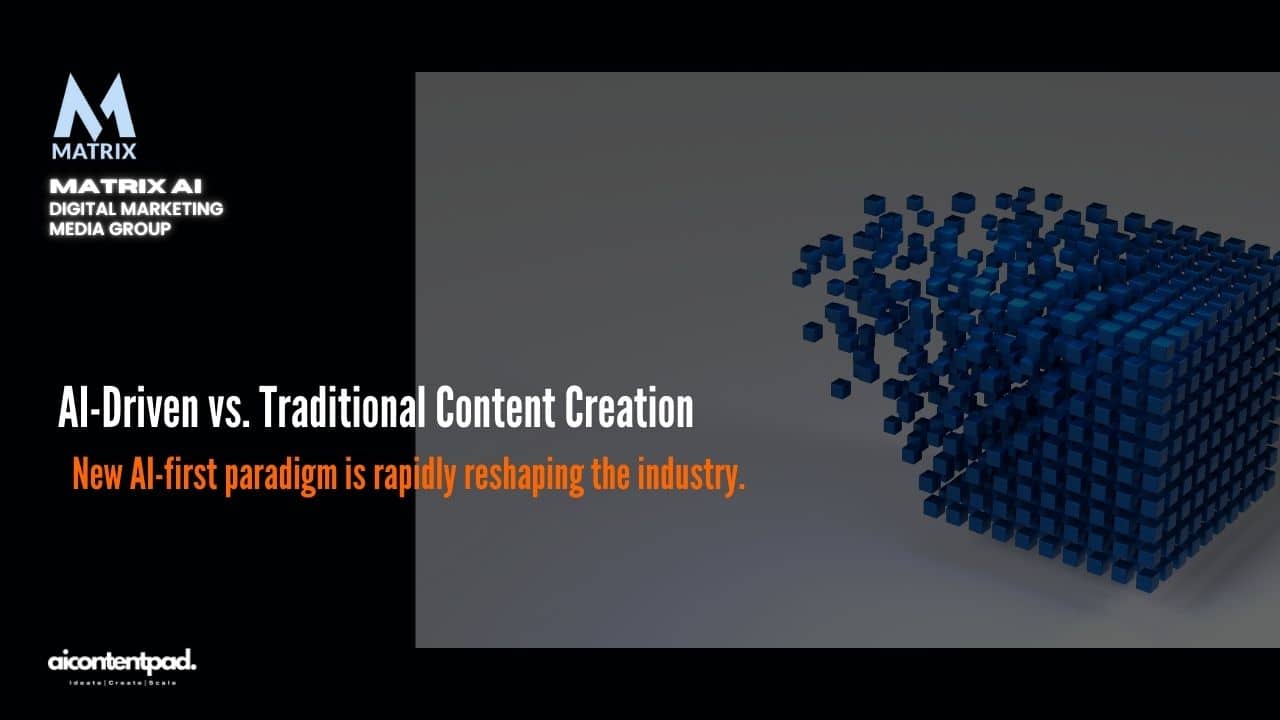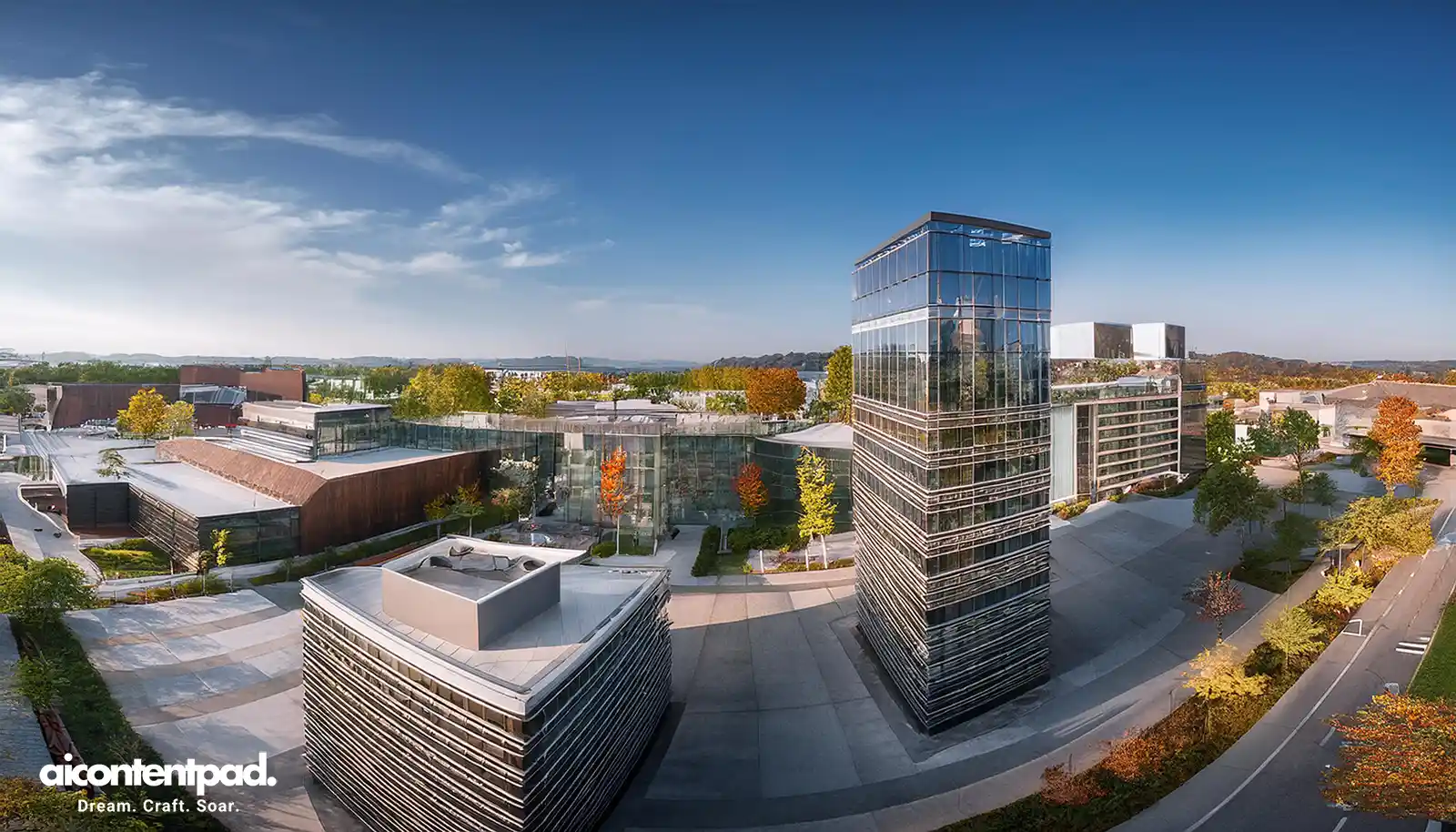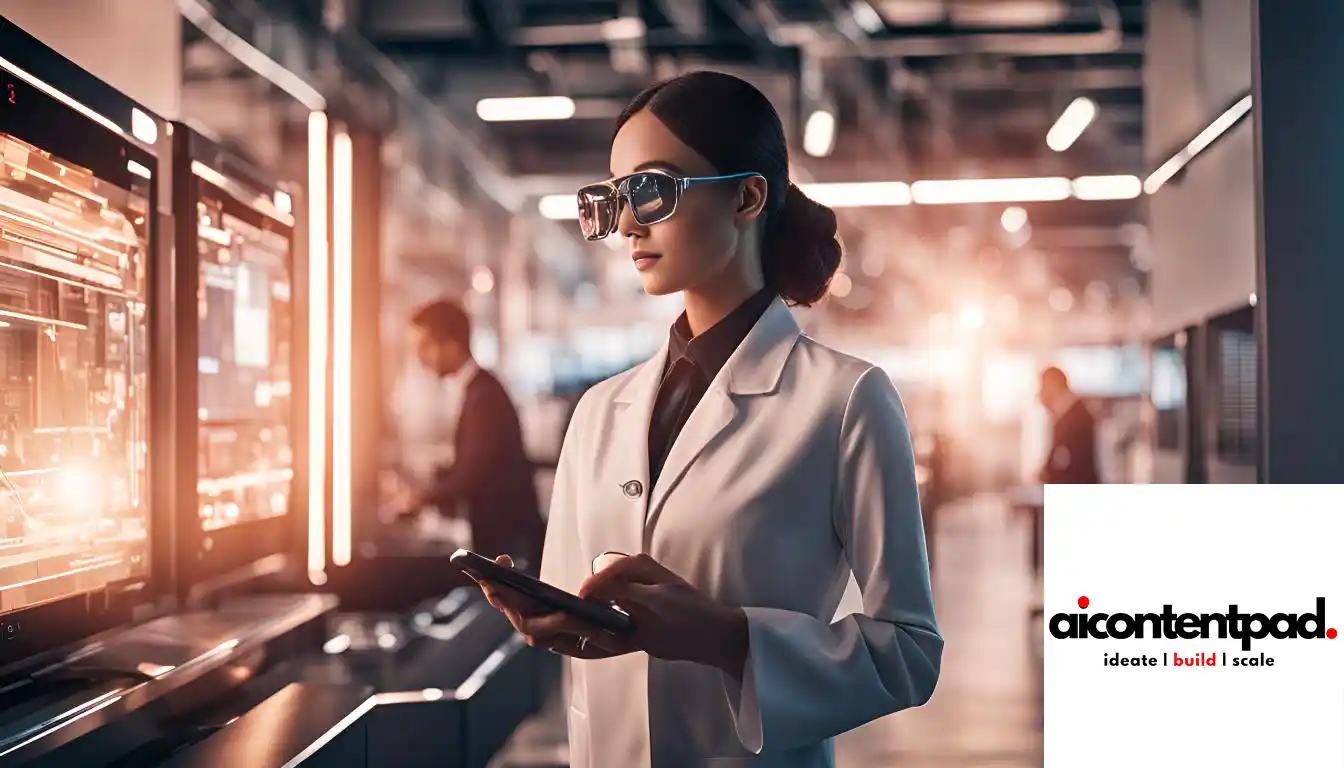Traditional Content Production vs AI-Driven Content Production: Navigating the Future of Marketing
Traditional Content Production vs AI-Driven Content Production: Navigating the Future of Marketing. What if you could save up to 70% on your content production cost?
In today’s fast-paced digital landscape, marketing managers must embrace the innovative wave of AI-driven content manufacturing or stick with traditional content production methods.
According to a recent study by Gartner, businesses that leverage AI in content creation see a 30% increase in engagement compared to those relying solely on traditional methods.
This compelling statistic underscores AI’s growing importance in marketing. But is this shift all it’s cracked up to be?
Let’s delve into the benefits and potential pitfalls.
The Allure of AI-Driven Content
AI-driven content manufacturing offers unprecedented speed and efficiency. Advanced algorithms can analyze vast data to generate personalized content tailored to specific audiences.
This means marketing managers can quickly respond to trends, producing relevant content at a scale that traditional methods struggle to match. Moreover, AI tools can optimize content for SEO, ensuring higher visibility and engagement.
However, concerns about authenticity and creativity often surface. Critics argue that AI-generated content lacks the human touch, potentially alienating audiences who crave genuine connection.
Traditional Content Production: The Human Touch
On the other hand, traditional content production is rooted in creativity and storytelling. Human writers bring unique perspectives and emotional depth to their work, crafting narratives that resonate personally.
This approach builds trust and authenticity—essential qualities in brand storytelling. Yet, the process can be time-consuming and resource-intensive, often leading to missed opportunities in fast-moving markets. AIProdPad Product Development Transformation Through AI-Driven Innovation [White Paper]
Balancing Innovation with Tradition
For marketing managers, the key is to strike a balance between innovation and tradition. Leveraging AI to handle repetitive tasks and data analysis can free human creators to focus on high-level strategy and creative development.
Combining AI’s efficiency with traditional methods’ creativity can lead to a powerful synergy, enhancing productivity and content quality.
Ultimately, choosing between traditional content production and AI-driven content manufacturing isn’t about choosing one over the other.
It’s about integrating both to create a robust content strategy that meets the demands of today’s market while staying true to the brand’s voice and values.
By addressing these concerns and providing clear, evidence-based recommendations, marketing managers can navigate this evolving landscape with confidence and clarity. Content Translation Services: A Competitive Advantage for Your Business
Traditional Content Production vs AI-Driven Content Manufacturing
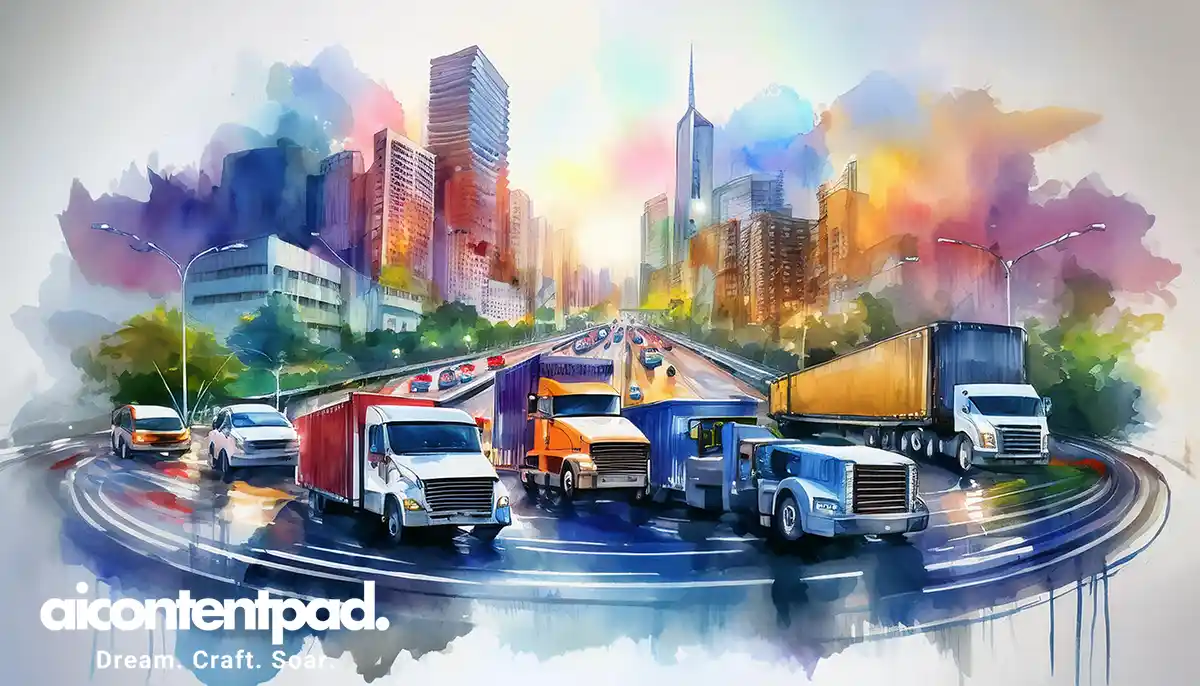
Understanding the Divide
The distinction between traditional content production and AI-driven content manufacturing is pivotal in marketing.
Traditional content production involves human-centric creative processes, where writers, designers, and videographers craft narratives, visuals, and multimedia-rich originality and emotion.
While time-intensive, this process often results in bespoke content that resonates deeply with audiences due to its nuanced and personal touch.
On the other hand, AI-driven content manufacturing leverages artificial intelligence technologies to automate and expedite content creation.
From generating text to designing visuals, AI tools analyze vast amounts of data, identify patterns, and produce content rapidly.
This approach is ideal for marketers looking to scale their efforts swiftly and efficiently. It offers personalization and adaptability that can be adjusted in real time based on audience engagement metrics.
Why and Where It Matters
Understanding this dichotomy is critical for marketing managers when strategizing content pillars.
Traditional methods are best suited for campaigns that require a human element, like storytelling or brand-centric initiatives that build deeper relationships.
Meanwhile, AI-driven manufacturing excels in data-heavy environments where speed, scalability, and testing numerous variations, such as programmatic ad campaigns or dynamic content systems, are essential.
These two approaches depend largely on the brand’s objectives and audience.
By harnessing both strengths, marketers can craft a versatile and responsive content strategy that captivates interest and optimizes engagement, ensuring the right message reaches the right audience at the right time.
This harmonious blend sparks innovation and establishes a competitive edge in today’s fast-paced digital landscape. Digital Marketing for Solar Companies to Increase Sales
The Bleeding Cost of Content Production
In today’s digital age, marketing managers face a formidable foe: the exorbitant cost of content production.
High-quality content is non-negotiable for brand visibility and customer engagement, yet the resources required to produce it are staggering.
From freelance writers to videographers and designers, the bills add up quickly, stretching budgets thin and diverting funds from other essential strategies.
Why This Problem is Draining Your Resources

The financial toll of content creation is more than just a numbers game; it hinders innovation and agility.
To estimate the cost of generating content from a team of five, you can break it down into key categories such as salaries, tools and software, and overhead. Here’s a simplified breakdown:
1. Salaries/Compensation
The largest cost will be team salaries, which vary by experience and location. Here’s an example of average salaries for content-related roles in the U.S.
- Content Writer: $70,000/year
- Editor: $75,000/year
- SEO Specialist: $85,000/year
- Graphic Designer: $75,000/year
- Content Manager: $95,000/year
Total Annual Salary Range: $400,000/year
If you pay contractors or freelancers, rates may vary from $50 to $150 per hour, depending on the expertise level.
2. Tools and Software
The content team will require tools for content creation, project management, and SEO optimization. Here are some typical tools:
- SEO/Analytics tools (e.g., Ahrefs, SEMrush): $300/month
- Content Management System (CMS): $300/month
- Graphic Design Tools (e.g., Adobe Suite, Canva): $100/month
- Collaboration Tools (e.g., Slack, Asana, ClickUp): $200/month
Total Monthly Tool Cost: $900
Total Annual Tool Cost: $10,800
3. Overhead Costs
Considering office space, utilities, and benefits (healthcare, insurance, etc.) if the team works in-house.
- Office Space: $$1,500/month per person (depends on location)
- Benefits/Healthcare: Approx. 30-35% of salary costs
- Miscellaneous: Training, conferences, etc.
Total Overhead Costs: Around 30-40% of salary costs
4. Total Estimated Costs
- Salaries: $400,000
- Tools: $10,800
- Overhead (30% of salaries):$120,000
Total Annual Cost Estimate: $530,800
What is the best way to get smart, faster, and cheaper content? We can capture value with up to 72% cost reductions for a content marketing team.
This gives you a rough estimate for maintaining a team of five for content generation. Costs vary widely depending on your organization’s region, experience level, and specific needs.
With budgets tied up, marketing managers often need to work on executing dynamic campaigns or pivoting strategies, which is crucial in an ever-evolving market.
The frustration grows as manual processes prolong turnaround times, leaving your brand behind faster-moving competitors.
Such inefficiencies affect your bottom line and risk losing your audience’s attention.
Your AI-Powered Solution: Efficient and Cost-Effective
Imagine transforming this bottleneck into a streamlined powerhouse with AI Marketing Solutions.
Our cutting-edge AI tools automate content creation, reducing the need for extensive human resources. By employing machine learning algorithms, your brand can generate personalized, high-quality content at a fraction of the time and cost.
Forget costly freelancers and endless revisions—our AI ensures consistency, scalability, and speed. Take control of your budget, reinvest in innovation, and regain your competitive edge.
With AI, shift from simply surviving to thriving in the fast-paced marketing landscape.
The Human Touch in Traditional Content Production
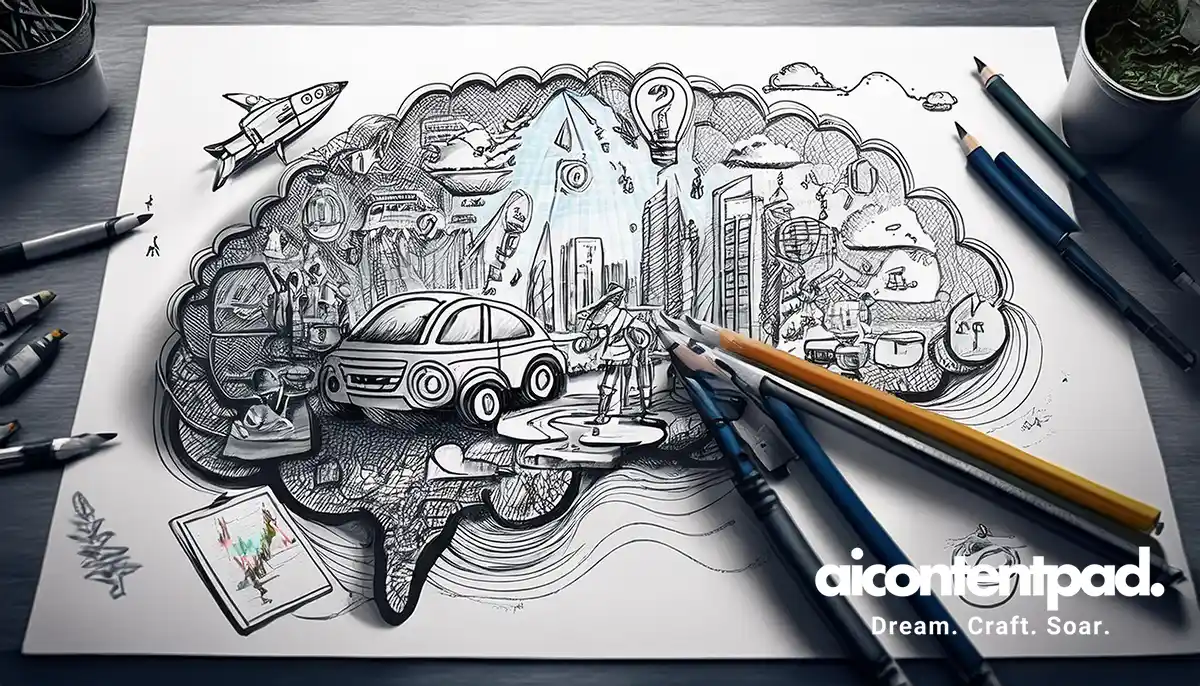
Sarah Linton, Marketing Director
“As a marketing professional with over 15 years of experience, there’s something inherently magical about traditional content production.
The artistry, creativity, and human emotion infused into each piece of content are irreplaceable. Traditional methods involve deep brainstorming sessions, collaborative efforts, and a profound understanding of the brand narrative.
This bespoke approach to content creation catches the nuances that resonate personally with the audience, creating that ‘aha!’ moment that AI still struggles to replicate.
In my opinion, it’s akin to comparing a handcrafted piece of art to a mass-produced item—each has its value, but the human touch often brings a unique warmth.”
AI-Driven Content: Speed and Scale as Game-Changers
Thomas Reynolds, Data-Driven Marketing Strategist
“The advent of AI in content manufacturing is a testament to how far technology has transformed industries.
As a data-driven strategist, I find AI’s capabilities fascinating, especially regarding speed and scalability. AI algorithms can analyze mountains of data to churn out relevant content in minutes, allowing companies to keep up with the fast-paced digital world.
AI-driven tools can personalize content incredibly granularly, ensuring each customer receives information tailored to their preferences. While it might lack the creative depth of human-generated content, AI’s efficiency cannot be overstated.”
Blending the Best of Both Worlds
Rebecca Chan, Chief Marketing Officer
“What excites me is the potential to fuse traditional content strategies with AI-driven methods. As the Chief Marketing Officer focusing on innovation, I see a future where creativity and technology dovetail seamlessly.
By integrating AI’s analytical prowess with humans’ knack for storytelling, businesses can produce content that is not only tailored but also emotionally engaging.
This balanced approach could be the gold standard for content creation in the coming years, allowing us to harness AI’s potential while keeping the soul of human creativity intact. It’s an era ripe for exploration, and I can hardly wait to see how it unfolds.”
The Power of Content: Traditional vs. AI-Driven Approaches
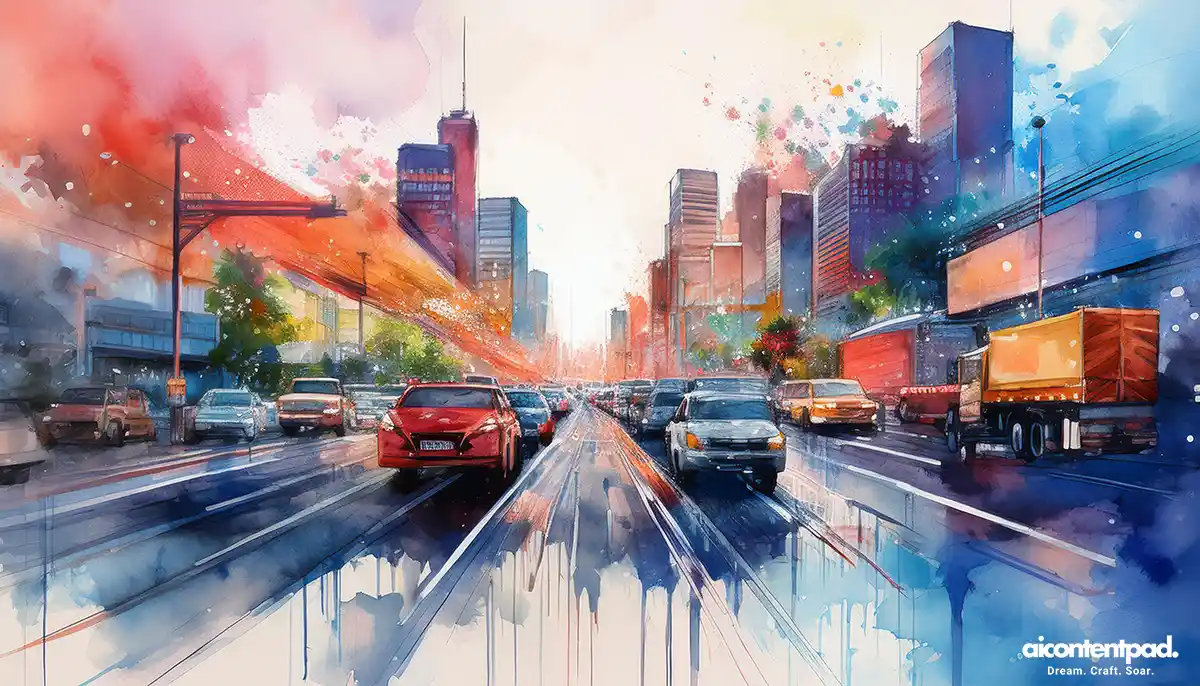
Old Meets New: Traditional Content Production
In traditional content production, crafting an engaging narrative relies on creativity and human intuition. The meticulous process includes brainstorming, drafting, and refining to evoke emotional audience connections.
An exemplary brand excelling in this method is Vistara Journeys, a boutique travel company known for its evocative storytelling. It transports readers to distant places and creates vivid imagery and memories.
By prioritizing quality and authenticity, Vistara Journeys effectively captures the imagination of its audience through well-crafted travel tales.
The Rise of AI: Streamlining Content Manufacturing
On the other hand, AI-driven content manufacturing harnesses technological innovations for efficiency and scale.
A prime example is TryScribe, a startup revolutionizing e-commerce by generating personalized product descriptions for thousands of items in seconds. With machine learning algorithms that analyze user preferences, TryScribe delivers tailored content that speaks directly to consumer needs.
This approach allows for rapid content updates based on market trends, offering unprecedented personalization.
Striking a Balance: Best of Both Worlds
Navigating the content creation landscape requires a strategic blend of traditional and AI-driven methodologies. NaturaLux, a niche skincare brand, has masterfully achieved this harmony.
By combining AI insights with human creativity, NaturaLux crafts personalized beauty guides for its customers.
It applies machine learning to analyze skin types while storytelling experts weave engaging narratives about product origins. This hybrid approach enhances customer engagement and builds trust and loyalty.
In conclusion, whether through traditional craftsmanship or AI-powered innovation, successful content production hinges on understanding the audience.
As Vistara Journeys, TryScribe, and NaturaLux exemplify, companies can spark curiosity and establish a strong brand presence by leveraging the merits of both approaches in today’s dynamic digital landscape.
Exploring the AI Solution from Matrix: Traditional Content Production vs. AI-Driven Content Manufacturing
In the ever-evolving landscape of content creation, the Matrix acts as a metaphorical playground, juxtaposing traditional content production against AI-driven content manufacturing.
Beginning this journey stirs a palpable curiosity, inviting creators to redefine methodologies and reimagine possibilities.
Unleashing the Power of Tradition
Traditional content production, grounded in human creativity, offers authenticity and relatability. It thrives on intimate storytelling, where human experiences and emotions spearhead engagement.
This process is all about craftsmanship—painstakingly drafting, revising, and refining content to weave narratives that resonate with audiences on a personal level.
Through research, inspiration, and relentless editing, traditional methods maintain an artistic touch that machines cannot replicate. However, these methods’ manual effort and time-intensive nature hint at a need for evolution, catalyzing the allure of the digital breakthrough embodied by AI.
Embracing the Age of AI-Driven Content
AI-driven content manufacturing emerges from the Matrix like a beacon of futuristic innovation, promising efficiency and scalability like never before. By harnessing algorithms and machine learning, AI systems sift through troves of data to generate precise content tailored to audience needs.
This technology expedites the content creation, allowing producers to generate high-volume content swiftly while maintaining consistent quality.
Automated tools also free up creative minds, enabling them to focus on strategy and refinement rather than basic content generation.
Yet, the challenge lies in balancing AI assistance with maintaining a human touch, ensuring the content remains genuine and emotionally engaging.
The Synthesis: A Harmonious Coexistence
Envisioning a harmonious synthesis between these two arenas, content creators can cultivate an enriched production model that leverages the strengths of both worlds.
This involves integrating AI tools to handle routine tasks while preserving the sophisticated artistry inherent in human creativity. The goal is not to replace but to augment, creating a new Matrix where tradition and technology coexist synergistically.
As professionals embark on this endeavor, they stand on the edge of a transformative journey, ready to unlock innovative content strategies that captivate and connect with audiences in profound ways.
As the Matrix unfolds, it challenges creators to continually explore these possibilities, expanding their horizons in content creation.
Take a Look through these samples of AI Gen 4 Art and images









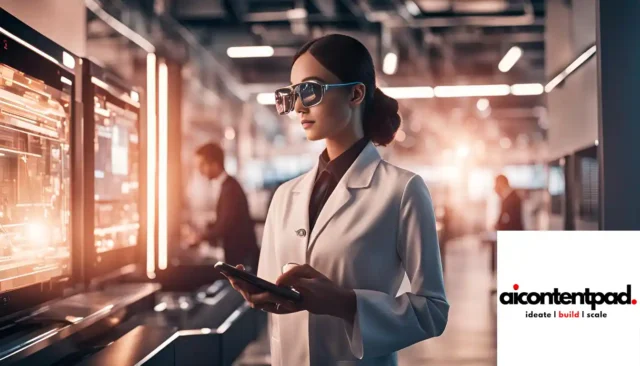














The Evolution of Content Creation
The debate between traditional content production and AI-driven content manufacturing intensifies as the digital landscape evolves.
Traditional content creation, rooted in creativity and human intuition, has historically been the backbone of storytelling. It emphasizes personal touch, authenticity, and emotional connection, which resonate deeply with audiences.
In contrast, AI-driven content manufacturing utilizes algorithms and data to produce content at unprecedented scales, potentially needing more nuance and emotional depth than human-generated content.
Benefits and Challenges of Traditional Content Production
Traditional content production relies heavily on human creativity and perspective.
Writers, artists, and filmmakers use their unique experiences to craft engaging and relatable narratives. This approach fosters a strong emotional bond with audiences and offers customization that algorithms struggle to replicate.
However, traditional methods’ labor-intensive nature can lead to higher costs and longer production times, significant drawbacks in today’s fast-paced digital environment.
AI-Driven Content: Opportunities and Concerns
AI-driven content manufacturing revolutionizes content production by leveraging machine learning and data analytics to quickly generate vast amounts of material.
AIContentPadTM: Automates content creation and management, ensuring marketing messages resonate with target audiences with text, audio, speech, image, and video.
What if you could save up to 70% on your content production? Would you?
This method offers unparalleled efficiency and can adapt to trends and audience preferences with real-time data analytics.
However, critics argue that AI lacks the human touch and fails to capture the authenticity and emotional connection that traditional content provides. Concerns about originality and the potential for misinformation also cast a shadow over its rapid adoption.
AI Branch Models for B2B Technology by MatrixLabX
AI-first paradigm rapidly reshapes the industry, replacing outdated structures with agile, efficient, and scalable approaches.
Bridging the Gap: A Collaborative Future
The future of content production may lie in a synergistic approach that combines the strengths of traditional and AI-driven methods.
By integrating human creativity with AI’s efficiency, content creators can explore new frontiers in storytelling while maintaining authenticity and emotional depth.
This hybrid model could redefine audience engagement, offering tailored experiences without compromising quality. As both methods coexist, finding a balance that respects the art of storytelling while embracing technological advancements remains.
AI Branch Models is a groundbreaking AI-first architecture designed to revolutionize marketing strategies for businesses across various industries. This innovative approach utilizes AI-powered systems to provide customized marketing solutions that are faster, better, and cheaper.
AI-Powered Tools for Enhanced Efficiency

At the core of AI Branch Models are three powerful AI agents:
- AIProdPadTM: Streamlines product development, launches, and marketing, aligning product life cycles with specific industry needs.
- AIContentPadTM: Automates content creation and management, ensuring marketing messages resonate with target audiences with text, audio, speech, image, and video.
- AIBrandPadTM: Develops communication frameworks and aligns corporate governance to ensure consistent brand messaging across all communication platforms and personalized messaging for the specific audience.
These AI-powered tools empower marketers to respond quickly to market shifts and maintain alignment with broader corporate goals and governance.

